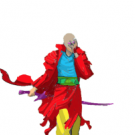-
Posts
1141 -
Joined
-
Last visited
-
Days Won
2
Ripheus23's Achievements
988
Reputation
Single Status Update
-
The deontic transkeys
Another example of the kind of problem of which ingratiation is an example, is the problem of threatening. I will not dwell on the argument too much at the moment but the essence of the idea is that threatening someone is never justified (this is not identical to the question of whether defensive violence is acceptable) because doing so amounts to attempting to make something forbidden by doing something supererogatory [which is the obverse of ingratiation, then].
In general, these moral phenomena are known as deontic transkeys, in which one deontic operator is transkeyed to another, such that the dynamic of one operator is used to bring another into play. Under the circumstances, I have not had indifferential permission as transkeyed to the other operators, the idea being that since the why-glyph* is externally negated in this case, the why-force doesn't apply to it and so the mediation of the operators via the why-force doesn't take place here. So, given the other four deontic operators in the fundamental graph, there are 16 transkeys possible (assuming that each of those four can be transkeyed to itself). Some are true, the others are false; e.g., as noted, it is false to transkey supererogation to obligation or prohibition so as to be ingratiating or threatening. But OTOH supererogations can give rise to other supererogations; and so on. I'm not sure how many incorrect transkeys there are but whatever the number, those are all aspects of the Form of Evil's mathematical structure, I suspect.
*[The why-glyph is the conversion of an imperative, "Do X," into the question, "Why do X?" In the case of indifferential permission, since there is no reason why X and no reason why not X, X is not subject to the why-force as such. By contrast, in differential permission, the disjunct {X or not X} as a whole is what there is a reason for, so differential permission is subject thus to the why-force.]
-
Recursive sins
It is possible to be recursively ingratiating, i.e. some people have a strong desire to be responsible and discharge their obligations rationally, and they can be preyed upon by being "given" the special chance to be responsible for something, the "gift" being given according to the negative logic of ingratiation in general. It is thought that this is the more invidious form of the corresponding deontic transkey error.
Related to the phenomenon of recursive hypocrisy, which is being hypocritical about other people's hypocrisy. [Hypocrisy appears to admit of a further recursive layer, in which one has double-standards about double-standards for double-standards, although few agents have ever been identified as performing the required warp in reasoning to reach this state of attitude.]
-




